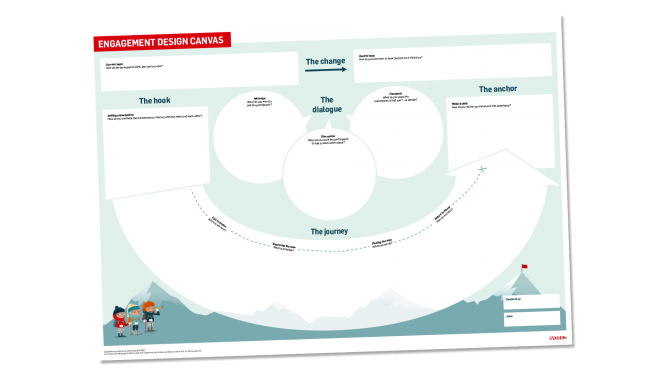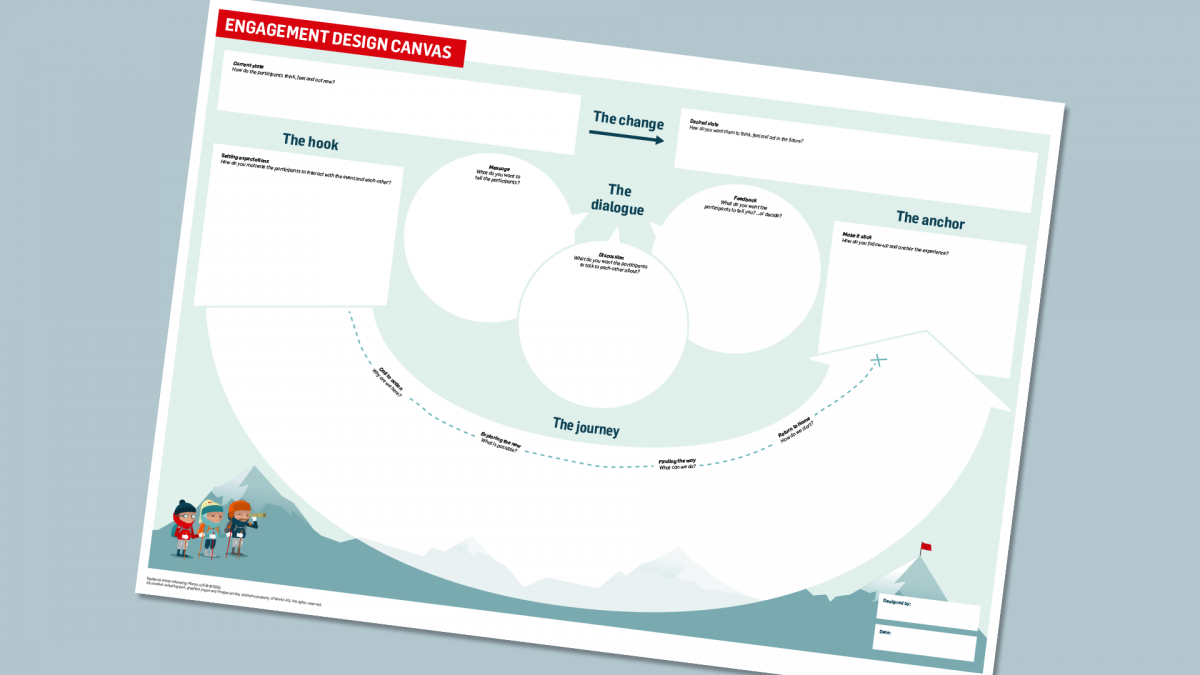Are you trying to change things in your organisation – in a big or small way? Are you comfortable with the communication plan, but unsure about how to engage and involve the organisation? Then this canvas may be just the tool you are looking for.
The Engagement Design Canvas helps you plan the engagement process and the dialogue you want to have with your stakeholders, employees, or leadership team. It works whether you are rolling out a new strategy, trying to create a customer-centric sales culture or improving the bond to external collaborators.
It is even a great help for designing summits or meetings. Thinking of events as focused engagement initiatives is not a bad approach.
The canvas combines several tools from our Workz toolbox; the human-centred change perspective, the Hero's Journey of strategic storytelling and experience design, and the concept of designed dialogues. Together these tools help you keep your focus on involvement, and not just communication.
The canvas is designed for you to start with the top row and work your way around the edge, finishing with the centre. But you can also just start wherever you feel firm ground and work your way from there.

The change
We always suggest that our clients approach a change process from the perspective of the change itself. Try to describe what it is you want to change with your engagement efforts.
Start with the current situation. Describe what the organisation is doing, saying and feeling right now. Focus on not just what you want to change, but also try to include the things you want to keep and the things that are already working in your favour.
Then, describe the desired situation after the engagement has taken place. What has changed and how does the organisation behave and think now?
Remember that it is not necessarily the participants you want to change. Maybe you want them to change something bigger - eg. you might be preparing a leadership conference, but it is the behaviour in the entire organisation you want to change.
The hook
Getting people involved takes motivation. It is one thing to get people to show up, another is to get them to invest energy into the engagement activities.
People are motivated in different ways, but we still have something in common. Motivations can be focussed on the individuals or on something bigger, and they can be emotional or rational.
Individual motivation focus on "what's in it for me?" and can be things like an opportunity for influence, or access to information or people. But motivation to participate can also come from the potential to do good for the organisation, your colleagues or even the world at large?
Rational motivation focus on responsibilities, rewards and future benefits, whereas emotional motivation focuses more on intangibles like prestige (one of a selected few to be invited), mystique (what will be revealed?) and thematics (hope).
Whatever motivational factors you decide to introduce, it is important to set the scene right from the get-go and highlight how the participants can make a difference. Make sure they are the hero of the journey you are preparing. Read more about motivation in Dos and donts of motivation.
It is important to not over-promise though. You must set the expectations right. The worst thing you can do is to promise real influence and then end up not using the input from the participants.
You can read more about setting expectations and choosing the right level of involvement in our article about the artcile Room for involvement.
The journey
In Workz, we see a change effort as a journey to a special world and back. It is inspired by the 12 steps of The Hero's Journey. Based on this we often break a meeting or summit into four steps; Call to action, Exploring the new, Finding the way, and Return to home.
As a core process, these four steps act as a red thread that binds the programme elements together, and make sure the participants find meaning in the chaos.
The Hero's Journey assumes that the participants have not started the journey yet, so it starts with a Call to action. It is a very common error to assume that the participants are on the same page as the organisers and have the same level of urgency. Spending a little time to highlight the why is always a good investment.
This is also where you can remind people who will benefit from the engagement, if it is not themselves; users, patients or citizens.
The two next steps open up the subject matter and invite the participants to explore potential solutions or agendas, before inviting them to choose for themselves what makes most sense. This is a classic open-and-close process which can be used to describe anything from a creative brainstorm to a best practise sharing.
Finally, as the last step, the participants are helped on how to bring the new knowledge with them and implement it in their own everyday lives. This step serves as a stepping-stone for the anchoring that takes place after the event or initiative.
In any way, these four steps are just a suggestion. Theory U or a classic three act structure, can also make a lot of sense.
The dialogue
Now it is time to put some meat on the bones of the canvas and dig into the conversations that will form the core of the change process. The key here is to not only focus on what you want to tell the participants, but also consider what you want them to talk about, and, in turn, tell you. In short, you have to think about not just communication but also involvement.
We do that by breaking the dialogue into three brackets or dimensions; the Message(s), the Discussion, and the Feedback. In these areas, you note down respectively what you want to communicate, what you want the participants the spend time discussing amongst themselves (and with you), and finally if there is something you want to know from the.
When filling out this part of the canvas it is important to look not only at the Change you want to bring about, but also at the Hook, the Journey (and the Anchor). All of these parts of the canvas can hold clues as to the dialogue you need to bring about.
Read more in this post, about the three dimensions of a designed dialogue. Here you can find additional ideas about how to use this framework.
The anchor
We have all been at conferences or in classes where we saw the light, got inspired to change our way of working or thinking, just to return to the old ways of working the moment we hit the offices and the mails started rolling into our mail boxes.
What we experience is the challenge of creating transfer; of making things stick and transforming good ideas into new behaviours.
In change management the cure for this is follow-up activities and anchoring. You focus on next step-procedures, feedback loops, incentives and reporting structures. And you make sure to repeat the messages again and again.
The best traditional tool for effective anchoring is the back-brief. Have the affected people tell back to you how they understand the task and what they plan to do. Read more here about back-briefing for empowerment.
Another way of creating transfer is to borrow the open-ended approach of design thinking. Like in the best movies, and open ending keeps you thinking long after the credits have rolled off the screen.
In change design you can achieve the same by not trying to conclude the discussions nicely, but instead ending on a question or a challenge. You then invite the participants to go back and find the answer, investigate what solutions work the best, or maybe even bring the question back with them and involve their own network or employees in finding the solution.
An open-ended process can be scary, especially if you want to control the message, but it has an almost viral potential that maybe exceeds that of more traditional clear-cut communication.
In any regards you have to make sure you spend some effort on anchoring the experience and transforming insights and involvement into action.
That is the secret behind real and effective engagement.

